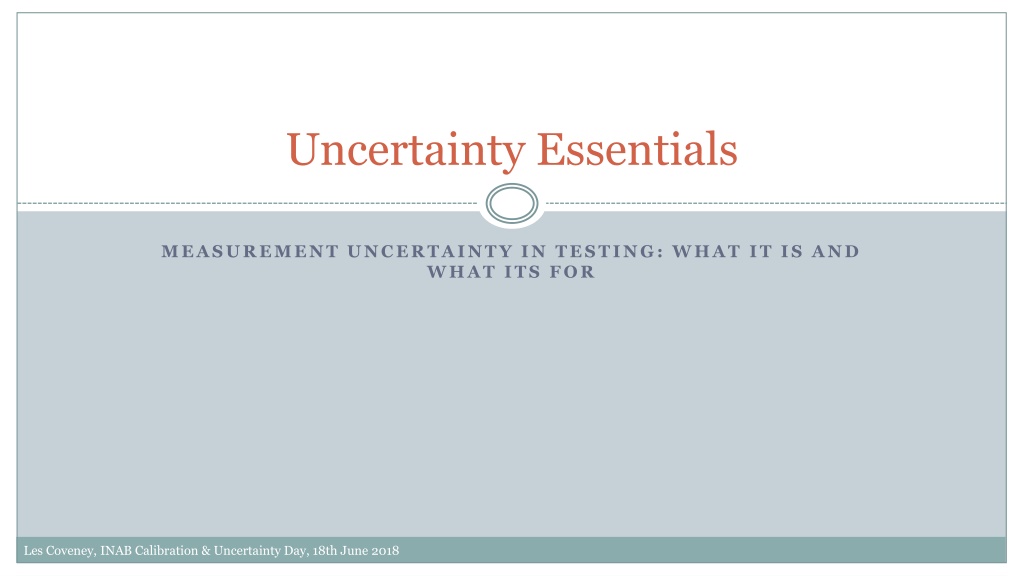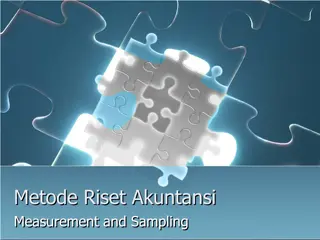Understanding Measurement Uncertainty in Testing: Essentials and Guidelines
Measurement uncertainty in testing is a crucial aspect that characterizes the dispersion of values attributed to a measurand. This uncertainty plays a key role in reporting accurate test results, requiring careful evaluation of all significant contributions. The ISO/IEC Guide 98 GUM provides essential guidelines for expressing and handling measurement uncertainty, ensuring reliable test outcomes and method performance assessments. Laboratories must meticulously identify and evaluate various sources of uncertainty to enhance the quality and credibility of their testing processes.
Download Presentation

Please find below an Image/Link to download the presentation.
The content on the website is provided AS IS for your information and personal use only. It may not be sold, licensed, or shared on other websites without obtaining consent from the author. Download presentation by click this link. If you encounter any issues during the download, it is possible that the publisher has removed the file from their server.
E N D
Presentation Transcript
Uncertainty Essentials MEASUREMENT UNCERTAINTY IN TESTING: WHAT IT IS AND WHAT ITS FOR Les Coveney, INAB Calibration & Uncertainty Day, 18th June 2018
Uncertainty Essentials Definition of Measurement Uncertainty Expression of Measurement Uncertainty 17025:2017 & 15189:2012 Requirements Use in selection of methods Use in reporting Statistics, Units and Calculations Standard deviation Transformation of non-normal data Harmonisation of scales & units Approaches to Estimation of Measurement Uncertainty Metrological approach Single Within-Laboratory Approach Qualitative Results Guidance Documents Les Coveney, INAB Calibration & Uncertainty Day, 18th June 2018
Definition of Measurement Uncertainty A parameter associated with the result of a measurement, that characterises the dispersion of the values that could reasonably be attributed to the measurand ISO/IEC Guide 98 GUM Uncertainty is a property of a test result Preferred form of reporting: Result: (x U) (units) Les Coveney, INAB Calibration & Uncertainty Day, 18th June 2018
Reference to Measurement Uncertainty Knowledge of method performance often contributes to estimates of uncertainty Reference is often made to uncertainty of a method Uncertainty must always be associated with a test result or range of test results Les Coveney, INAB Calibration & Uncertainty Day, 18th June 2018
17025:2017 7.6.1 Laboratories shall identify the contributions to measurement uncertainty. When evaluating measurement uncertainty, all contributions that are of significance, including those arising from sampling, shall be taken into account using appropriate methods of analysis. 7.6.3 A laboratory performing testing shall evaluate measurement uncertainty. Where the test method precludes rigorous evaluation of measurement uncertainty, an estimation shall be made based on an understanding of the theoretical principles or practical experience of the performance of the method. Les Coveney, INAB Calibration & Uncertainty Day, 18th June 2018
17025:2017 6.4.5 Equipment performance specifications 7.2 Selection, Verification and validation of methods 7.8.3 Test Reports: where applicable, the measurement uncertainty presented in the same unit as that of the measurand or in a term relative to the measurand (e.g. percent) when: it is relevant to the validity or application of the test results; a customer's instruction so requires, or the measurement uncertainty affects conformity to a specification limit; Les Coveney, INAB Calibration & Uncertainty Day, 18th June 2018
17025:2017 NOTES In those cases where a well-recognized test method specifies limits to the values of the major sources of measurement uncertainty and specifies the form of presentation of the calculated results, the laboratory is considered to have satisfied 7.6.3 by following the test method and reporting instructions. For a particular method where the measurement uncertainty of the results has been established and verified, there is no need to evaluate measurement uncertainty for each result if the laboratory can demonstrate that the identified critical influencing factors are under control. Les Coveney, INAB Calibration & Uncertainty Day, 18th June 2018
ISO 15189:2012 The laboratory shall determine measurement uncertainty for each measurement procedure in the examination phases used to report measured quantity values on patients samples The laboratory shall define the performance requirements for the measurement uncertainty of each measurement procedure and regularly review estimates of measurement uncertainty . upon request, the laboratory should make its estimates of measurement uncertainty available to laboratory users. Les Coveney, INAB Calibration & Uncertainty Day, 18th June 2018
Standard Uncertainty Uncertainties are usually quantified as standard deviations Standard uncertainty, u Expanded uncertainty, U = k.u k = coverage factor, usually 2 The reported uncertainty is an expanded uncertainty calculated using a coverage factor of 2 which gives a level of confidence of approximately 95 % Estimation of uncertainty for test methods utilizes the arithmetic of standard deviations. Les Coveney, INAB Calibration & Uncertainty Day, 18th June 2018
Transformation & Harmonisation Use of standard deviations implies that data conforms to normal distribution Data from some types of measurement may need to be transformed before they can analysed E.g. microbiological counts Log10 Results from quantitative PCR measurements - Log10 Data from calibration certificates and other sources may need to be converted to standard deviations Les Coveney, INAB Calibration & Uncertainty Day, 18th June 2018
Transforming Ranges to Standard Deviations Source Precision Bias Transformation sr and sR used directly sB estimated from validation data see later Divide by 2 (or k) Expanded uncertainties from calibration certificates Tolerance limits stated as x Rectangular distribution: divide by 3 Triangular distribution: divide by 6 Tolerance limits stated as x, but where manufacturer aims to be close to specification Constant weight limits Rectangular distribution: divide by 3 Les Coveney, INAB Calibration & Uncertainty Day, 18th June 2018
Approaches to Estimating Uncertainty Modelling Approach ( bottom-up ) Used extensively for metrological testing methods but rarely successfully applied to complete chemical or microbiological methods Refs: Eurachem 2012 Single Laboratory Validation Approach ( top down ) Applied extensively for chemical or microbiological methods, relying principally on estimates of reproducibility and bias Internal estimates of reproducibility and bias, and/or use of PT results to estimate bias Ref: Eurachem 2012, Nordtest 2004, Eurolab 2007 Les Coveney, INAB Calibration & Uncertainty Day, 18th June 2018
Single Within-Laboratory Validation Measurement accuracy = precision + trueness Measurement uncertainty = within-laboratory reproducibility + uncertainty on bias 2+ ?2 ? = ?? Where u = standard uncertainty, sR is reproducibility of method, b is bias of method at level of test result. Les Coveney, INAB Calibration & Uncertainty Day, 18th June 2018
Uncertainty in Qualitative Results Uncertainty in qualitative results not addressed in general guidance documents Yes/no, presence/absence, pass/fail Some published papers on estimation using complex statistical techniques e.g. Bayes theorem. Require high expertise & software Some aspects of verification may implicitly include some sources of uncertainty Setting of cut-off values Les Coveney, INAB Calibration & Uncertainty Day, 18th June 2018
Uncertainty in Qualitative Results Where results are expressed in qualitative terms, there is no expectation of a quantitative estimate of measurement uncertainty Unless a prior quantitative test result produced Factors affecting the test result need to be identified and shown to be appropriately controlled. Les Coveney, INAB Calibration & Uncertainty Day, 18th June 2018
The phase of the moon? Analytical Methods Committee, AMCTB No 61 Les Coveney, INAB Calibration & Uncertainty Day, 18th June 2018
Guidance Documents ISO/IEC Guide 98-1:2009 Uncertainty of measurement Part 1: Introduction to the expression of uncertainty in measurement Part 3: Guide to the expression of uncertainty in measurement (GUM:1995) EURACHEM / CITAC Guide CG 4 Quantifying Uncertainty in Analytical Measurement, Ed 3, 2012 Eurolab Technical Report No 1/2007. Measurement Uncertainty Revisited: Alternative Approaches to Uncertainty. Handbook for calculation of measurement uncertainty in environmental laboratories (NT TR 537 - Edition 3.1) EURACHEM / CITAC Guide Measurement Uncertainty Arising From Sampling - A Guide To Methods And Approaches, Ed 1, 2007 ISO 5725 Accuracy (Trueness and Precision) of Measurement Methods and Results (6 parts) The Phase-of-the-Moon Paradox in Uncertainty Estimation. Analytical Methods Committee, AMCTB No 61 Les Coveney, INAB Calibration & Uncertainty Day, 18th June 2018
Uncertainty Essentials Definition of Measurement Uncertainty Expression of Measurement Uncertainty 17025:2017 Requirements Use in selection of methods Use in reporting Statistics, Units and Calculations Standard deviation Transformation of non-normal data Harmonisation of scales & units Approaches to Estimation of Measurement Uncertainty Metrological approach Single Within-Laboratory Approach Guidance Documents Les Coveney, INAB Calibration & Uncertainty Day, 18th June 2018























